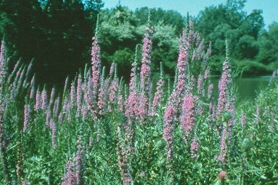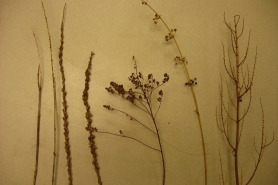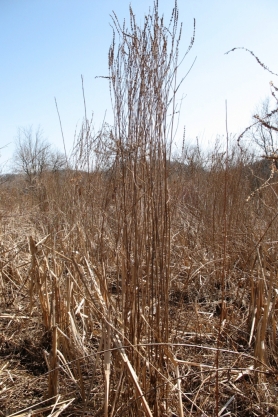Purple loosestrife
(Lythrum salicaria)
Wetland perennial, three to seven feet tall, with up to 50 stems topped with purple flower spikes. One prominent leader stems but many side branches often make the plant look bushy. Clipped plants grow back and cut stems readily re-root in the soil to produce new plants. Many areas of the state use safe biocontrol beetles that feed on the loosestrife to keep it in check and allow other plants to grow.
Other names for this plant include:
- Common words: spiked loosestrife
- Scientific names: L. salicaria var. tomentosum; L. salicaria var. vulgare
Classification in Wisconsin: Restricted
Ecological Threat
- It prefers moist soils and shallow waters competing with native wetland plants. It will adjust to varying light conditions and water levels.
- It has been widely planted as an ornamental where it escapes to nearby waterways. It is sold in nurseries as a sterile variety but can still produce viable wild-type seeds.
Identification
Leaves: Simple, lance-shaped and do not have petioles. Usually opposite and rotated 90 degrees from those below but are sometimes whorled.
Flowers: Closely attached to the stem with five to six pink-rose colored petals. Blooms from the bottom of the flower spike to the top from late June to September. Plants can bloom the first year after seeds germinate.
Fruits & seeds: Capsules start bursting open from the bottom of the inflorescence upwards from July through October, often while still flowering above. A single stem can produce 100,000-300,000 seeds per year. Mature plants with many stems can produce two million seeds. Seeds are viable for at least seven years.
Roots: Large woody taproot and many side roots. Plants intertwine to form dense clumps.
Stems: Green, sometimes tinged purple, stiff, erect, and generally four-sided (older stems, five or six-sided).
Similar species: Garden yellow loosestrife (Lysimachia vulgaris) is a non-native, wetland garden escapee with yellow flowers. Smaller, native-winged loosestrife (L. alatum) is found in moist prairies and wet meadows. It has winged, square stems, solitary flowers in separated leaf axils, paired lower leaves and alternate upper leaves. Swamp loosestrife (Decodon verticillatus) arches from shorelines and primarily whorled leaves and flowers in well-separated leaf axils.
Identifying purple loosestrife in spring
(click image to enlarge) Spring purple loosestrife stem tops and seed pods.
(click image to enlarge) Spring purple loosestrife and native wetland look-a-like stem from left: two-year-old plant, one-year-old plant, Steeplebush (Spiraea tomentosa), Swamp Loosestrife (Decodon verticillatus), Great Water Dock (Rumex britannica).
(click image to enlarge) Spring purple loosestrife clumps without leaves or flowers.
Distribution
See the reported locations of purple loosestrife in Wisconsin.
Do you know of other populations? Please send us a report.
Would you like to do something about purple loosestrife infestations? Visit the purple loosestrife biocontrol page to learn more.
Control
Mechanical: Young, small plants can be dug or pulled. Larger plants can be explored if all root fragments are removed. Burn, landfill or bury all plant parts deep in the ground. Mowing is not recommended as plant parts re-sprout and seeds may be dispersed.
Chemical: Imazapyr or glyphosate works well against purple loosestrife. If near water a permit may be required and aquatic-use formulas of these herbicides should be used.
Biological: Galerucella beetles have been successful in many parts of the state in controlling purple loosestrife populations. Want to get involved with biocontrol? Please find out more on our purple loosestrife biocontrol page.
Resources
Sources for content:
- Czarapata, Elizabeth; Invasive Plants of the Upper Midwest: an illustrated guide to their identification and control. The University of Wisconsin Press. 2005. Pg. 65-68
Links for more information






